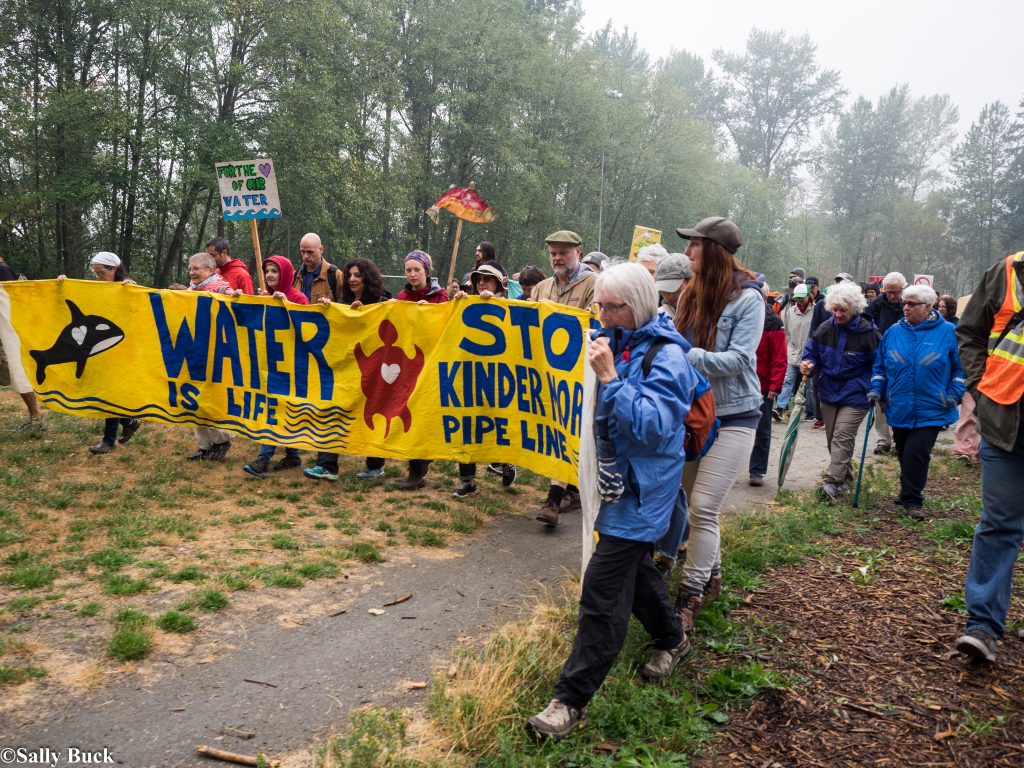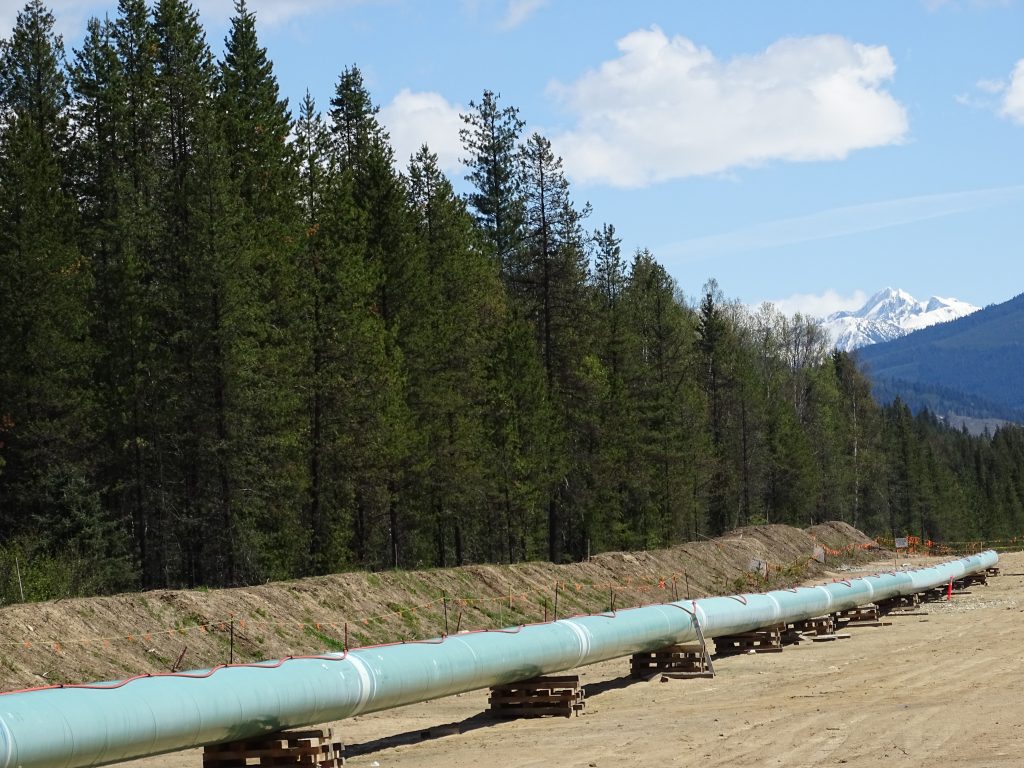1 Case Study 1 : Trans Mountain Pipeline Expansion
Case Highlights
The video below provides a quick introduction to the Trans Mountain Pipeline Expansion Case
- The Trans Mountain Pipeline Expansion promised to support Western Canadian crude oil production growth and provide a great boost to the economy and government revenues. However, it also threatened Indigenous lands and BC’s natural environment.
- The Trans Mountain Pipeline was purchased by the Canadian government in 2018 after construction halted. The project subsequently gained regulatory approval and the legal support of the Supreme Court, but has continued to be the target of Indigenous and environmental activists while suffering from construction delays and severe cost overruns that threaten to make it unprofitable.
- The short history of the Trans Mountain Pipeline is a study in the dangers and complications of government intervention, the challenges posed by regulation and Canada’s federal system, and the limits of a purely economic analysis of value and risk.
- The case involves diverse dimensions related to legal, political, financial, and environmental factors and challenges. It connects closely to ongoing debates over the appropriate scope and character of governmental consultation with Indigenous peoples.
- Studying and learning from the challenges faced by major projects, such as the hotly politically and publicly debated expansion of the Trans Mountain Pipeline in Western Canada can help us better understand ongoing and complex policy matters that involves a wide variety of stakeholders

Image by Sally T. Buck CC BY-NC-ND
Case Description
The Trans Mountain Pipeline was constructed in 1953, connecting Alberta’s crude oil-rich oilsands through 1,150 km of pipeline to the refineries and export terminals of southern British Columbia and Washington State. From there, Western Canadian oil could reach the demanding Pacific markets of South-East Asia, fetching significantly higher prices than the predominantly rail-carried oil shipped to the USA.[1] In 2013 its owner, Kinder Morgan, applied to Canada’s National Energy Board (NEB) for approval to expand the Trans Mountain Pipeline from Strathcona County near Edmonton, Alberta, to Burnaby, British Columbia. The Expansion Project promised to boost capacity from 300,000 to almost 900,000 barrels per day, supporting Western Canadian crude oil production growth and providing a great boost to the Canadian economy. Along such lines, Kinder Morgan and allies of the expansion project promoted the pipeline as serving the public interest and benefiting all Canadians by creating thousands of strong middle-class jobs, improving access to the global energy market, and increasing government revenues.[2] Consequently, the federal government came under pressure to support and, if necessary, directly ensure the completion of the enormous infrastructure project.

Map by the National Energy Board of Canada Crown Copyright
Almost from the moment it was proposed, however, the Trans Mountain Expansion Project generated divisive conflicts, primarily associated with the degree of its potentially detrimental environmental impact. The project approval process required two NEB report recommendations, and was met with determined protests from environmentalists and First Nations groups.[3] In 2018, Environment and Climate Change Canada estimated the expanded pipeline will annually release 21-26 megatonnes of GHG emissions.[4] Environmental activists, however, were most sharply concerned with the increased likelihood of an ecologically disastrous oil spill along the pipeline’s path through key local aquifers. This concern was strongly shared by First Nations groups whose traditional lands and sources of drinking water the pipeline expansion threatened.[5] The Secwepemc First Nation, for example, vowed to defend the 518 km of unceded territory the pipeline expansion intended to cross.[6] Legal action and local activism slowed construction to such an extent that in May 2018, Justin Trudeau’s Liberal government announced a deal had been reached to purchase Trans Mountain from Kinder Morgan for $4.5 billion.[7]
In August 2018, the Federal Court of Appeal’s decision to quash federal approval for the project pushed Kinder Morgan’s shareholders to complete the sale. This expensive acquisition exposed the project to new political risks, as it entered the national political purview to become a federal election issue and a catalyst for discussions on energy and environmental policy and Indigenous sovereignty. Diverse disagreements ranging from the assessment process (i.e. scoping, consultation, and jurisdiction) to project impacts (i.e. economic, environmental) have emerged.[8] More broadly, a national debate has ensued as the Canadian public became the investor in a megaproject that had been lauded by some for its long-term economic benefits and vilified by others for disregarding Indigenous rights and environmental conservation. In addition to the up-front $4.5 billion expense, Ottawa took on the even more immense costs of completing the pipeline expansion, demands by the BC government to commit federal funds to ward against ecological damage that could occur as a result of the project and increased tanker traffic, compensation deals with Indigenous groups whose land the pipeline crossed, and the risk of cleaning up a catastrophic leak. On the other hand, the potential increase to oil sector revenues and contributions to national GDP was estimated at $15 billion per year while the federal government suggested the expansion project would create 15,000 jobs, with operating the new pipeline requiring over 400 further skilled workers in a permanent capacity.[9]

Image by Adam Jones CC BY 2.0
Following the government’s purchase of the pipeline in 2018, several court challenges were filed against it and ultimately successfully overturned the pipeline’s approval, with the Federal Court decision citing the government’s failure to adequately consult with affected First Nations groups or assess and take steps to minimize the expansion project’s environmental impact.[10] In June of 2019, the Government of Canada approved the Trans Mountain Expansion Project subject to 156 conditions to be enforced by the Canada Energy Regulator. Construction was initially scheduled to finish in 2022 and cost Canadian taxpayers $12.6 billion.[11] In 2020, the pipeline won a major victory when the Supreme Court dismissed an appeal to the project’s approval, thereby concluding further legal challenges.[12] By 2022, however, Trans Mountain had pushed the projected completion date to late-2023 and blamed the COVID-19 pandemic, flooding in British Columbia, and project enhancements for the expected cost having risen 70% to $21.4 billion. While Alberta’s government and Canada’s oil and gas industry insisted the project remained essential to the national interest, the rising cost only intensified divisive debates over the value and potential impact of the pipeline.[13] Following up on a request from NDP environment and climate change critic Laurel Collins for an updated cost analysis, in the spring of 2022 Canada’s Parliamentary Budget Officer Yves Giroux stated the government’s Trans Mountain investment was “clearly not profitable” and would “mean losses for Canadian taxpayers whenever the government decides to sell the pipeline to a private-sector entity.”[14]
The Trans Mountain Pipeline megaproject constitutes a timely megaproject case study that continues to be the subject of heated debate across Canada, has immense implications for the Canadian economy, and stirs up a number of important political debates that impact public servants across the country. These include concerns over the appropriate role and scope of government intervention in the economy, management of public funds, maintaining inter-governmental relations within our federal system, and balancing important goals such as reconciliation and environmental protection with economic outcomes. In this way, the case study illustrates how megaprojects bring to light the foremost goals and values of a society and significantly affect huge populations, and consequently tend to place public servants engaging with them at the centre of intensive and often divisive public debate. In reviewing the Trans Mountain Pipeline, one can gain unique insights into how decisions on expensive infrastructure projects are not a matter of simple economic calculations, but rather involve complex political and sociological trade-offs at diverse levels of government. Additionally, it illustrates how public servants may be tasked with working to promote and fulfill projects that might clash strongly with some of their personal and moral beliefs.
For students of public policy and public administration, there are three particularly prominent factors of the Trans Mountain Pipeline case study. Firstly, the furor of intensified criticism and legal and activist challenges that followed the purchase of the pipeline from Kinder Morgan speaks to the impact of government intervention, and more specifically the dangers and complications that public ownership incurs for complex infrastructure and other major projects. Secondly, the case study ties closely to the importance of and challenges posed by regulation and the associated hurdles it presents to public servants in Canada’s federal system. Lastly, the divisive debates that have surrounded the pipeline point to the limits of economic analysis in assessing the value and risk of public projects, with impacts on Indigenous rights, environmental responsibilities, interprovincial rivalries and so on also relevant to the decision-making calculus.
Resources
- “Dire differential: How to deal with the oil price discount costing Canada billions.” Clare Clancy, Edmonton Journal, November 16, 2018. https://edmontonjournal.com/news/politics/dire-differential-how-to-deal-with-the-oil-price-discount-costing-canada-billions/.
- Article discusses the severe price discount on Western Canadian oil, details its impact on the Canadian economy, and succinctly outlines the policy options available for governments to actively address the issue.
- “Why the low prices for Canadian oil?” CBC News: The National, November 28, 2018. https://www.youtube.com/watch?v=lxFKtDF1df0.
- Short video concisely breaks down the issues Canada’s oil patch faces, their wider economic impact, and the economic need for pipelines to reach new markets.
- “Trans Mountain Expansion Project.” Government of Canada, modified July 5, 2021. https://www.canada.ca/en/campaign/trans-mountain.html.
- Official Government of Canada webpage describing the project, completed progress, and rationale for the TMX. Includes links to pages describing the government’s efforts to protect the environment and engage indigenous groups.
- “Trans Mountain – CER Conditions.” Trans Mountain. https://www.transmountain.com/cer-conditions.
- Webpage details the 156 conditions the Canada Energy Regulator is enforcing against the Trans Mountain Expansion project, which were key to appeasing or adequately reconciling with pipeline-related concerns raised by the Canadian public, local and provincial governments, and Indigenous communities.
- Conditions: https://www.ceaa-acee.gc.ca/050/documents/p80061/130549E.pdf
- “Supreme Court rejects Indigenous challenge to Trans Mountain pipeline approval.” Mia Rabson, Global News, July 2, 2020. https://globalnews.ca/news/7131113/supreme-court-rejects-trans-mountain-challenge/.
- Article presents the responses of the various major stakeholders involved in the Trans Mountain expansion following the Supreme Court’s decision to uphold it.
- https://thenarwhal.ca/topics/trans-mountain-pipeline/ ↵
- https://www.canada.ca/en/campaign/trans-mountain/what-is-tmx/the-decision.html ↵
- https://decisions.fca-caf.gc.ca/fca-caf/decisions/en/item/343511/index.do\ ↵
- https://www.thestar.com/news/canada/2018/06/01/key-questions-answered-about-ottawas-takeover-of-the-trans-mountain-pipeline-project.html ↵
- https://www.ctvnews.ca/business/court-ruling-quashes-approval-of-trans-mountain-1.4073752 ↵
- https://thenarwhal.ca/topics/trans-mountain-pipeline/ ↵
- https://www.cbc.ca/news/canada/calgary/kinder-morgan-canada-shareholders-vote-sale-trans-mountain-pipeline-1.4804503 ↵
- https://cases.open.ubc.ca/trans-mountain-pipeline-expansion-project/ ↵
- https://www.thestar.com/news/canada/2018/06/01/key-questions-answered-about-ottawas-takeover-of-the-trans-mountain-pipeline-project.html ↵
- https://decisions.fca-caf.gc.ca/fca-caf/decisions/en/item/343511/index.do ↵
- https://majorprojects.alberta.ca/details/Trans-Mountain-Pipeline-Expansion/614 ↵
- https://www.cbc.ca/news/canada/british-columbia/trans-mountain-pipeline-challenge-bc-first-nations-supreme-court-of-canada-1.5634232 ↵
- https://globalnews.ca/news/8631044/trans-mountain-pipeline-cost-climbs/ ↵
- https://thenarwhal.ca/trans-mountain-trudeau-pbo/ ↵

